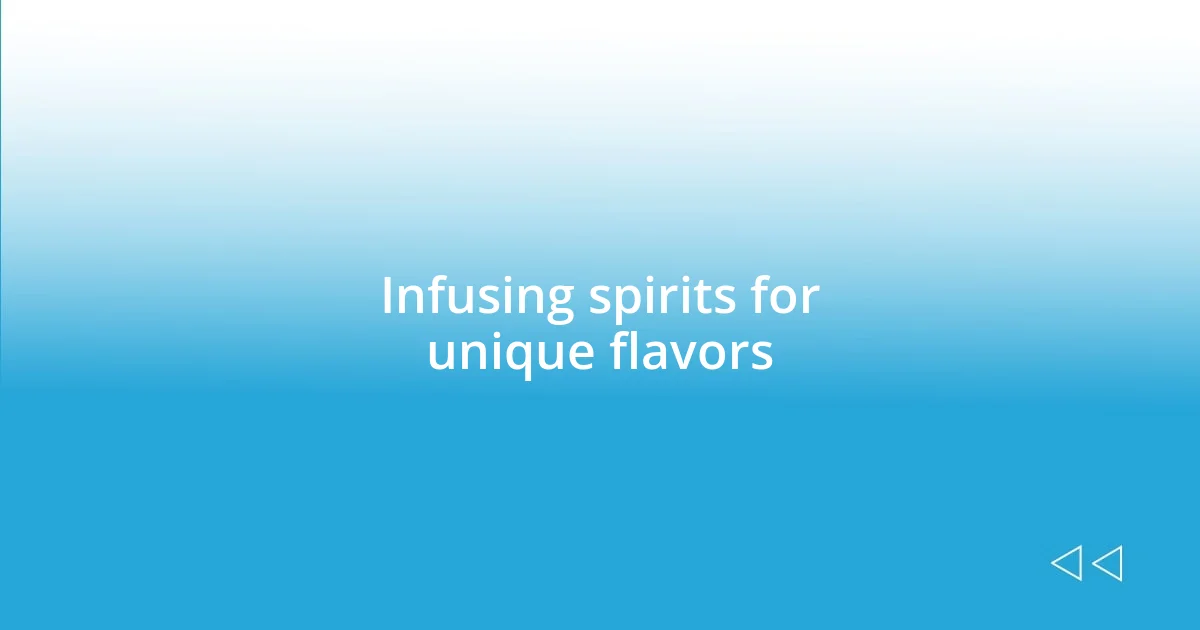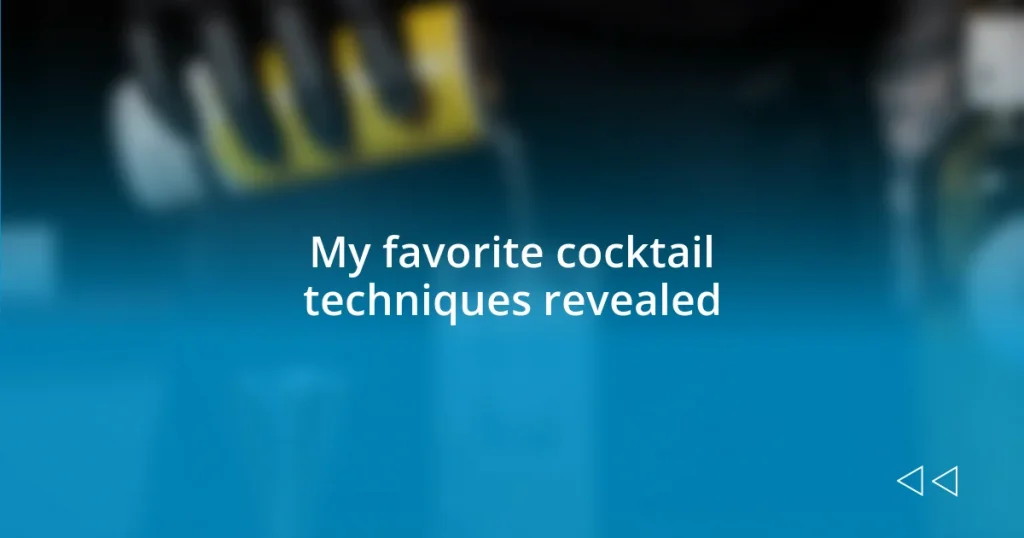Key takeaways:
- Essential cocktail tools like a jigger, shaker, and strainer are crucial for precise measurements and smooth pours, enhancing the overall cocktail experience.
- Understanding flavor profiles—sweet, sour, bitter, and salty—is key to crafting well-balanced cocktails that delight the palate.
- Creative techniques such as muddling, infusing spirits, and garnishing not only elevate cocktails aesthetically but also enhance their flavors and sensory appeal.

Essential cocktail tools needed
When it comes to mixing cocktails, having the right tools is essential. I remember the first time I tried to make a cocktail without a proper jigger – my measurements were all over the place, and the drink turned out awful. A jigger, which is simply a small measuring tool, is crucial for ensuring that you get the balance of flavors just right. Have you ever tasted a cocktail that was too sweet or too strong? That’s the consequence of careless measuring.
Another must-have in my cocktail toolkit is a shaker. The moment you shake up your ingredients—it’s like creating a mini party in your glass! The sound of ice clinking together makes me feel excited about the drink I’m about to enjoy. Did you know there are two types of shakers? I prefer the Boston shaker because of its versatility; it allows me to use various glass types and techniques without feeling restricted.
Lastly, don’t underestimate the power of a good strainer. The first time I realized how vital it is was when I found bits of ice in my cocktail; it’s not a fun experience! A fine mesh strainer helps achieve a smooth pour, ensuring that your cocktail is as polished and delightful as your favorite bar’s version. Think about it: Wouldn’t you want your guests to sip on something that looks and tastes impeccable? Having these essential tools elevates your cocktail game and makes the whole process more enjoyable.

Understanding flavor profiles
Understanding flavor profiles is vital for any aspiring mixologist. I find it fascinating how the balance of sweet, sour, bitter, and salty can transform a simple drink into an extraordinary experience. When I started mixing cocktails, I was often overwhelmed by the number of flavors available. It took me time to realize that understanding how these flavors interact is the key to creating a cocktail that pleases the palate.
For instance, did you know that adding a splash of citrus can elevate a cocktail’s refreshment factor? I once crafted a gin and tonic without lime, and my friends remarked that it tasted flat. The following week, I tried it with freshly squeezed lime juice, and the difference was remarkable! It was as if the cocktail came alive, awakening the senses with every sip. This experience taught me that playing with flavors is not just about adding ingredients but understanding their roles in the overall profile of a drink.
To help illustrate this concept further, here’s a comparison of flavor profiles in cocktails that I often refer to:
| Flavor | Description |
|---|---|
| Sweet | Balances bitterness; enhances drinkability. |
| Sour | Adds brightness and freshness; often comes from citrus. |
| Bitters | Provides depth and complexity; just a dash can transform a drink. |
| Salty | Enhances sweetness and suppresses bitterness; think salted rims or olive brine. |

Mastering shaking and stirring
Mastering the art of shaking and stirring is like learning to dance—there’s rhythm and technique involved. I remember the first time I tried my hand at shaking a cocktail; the ice seemed to be my opponent, flying everywhere as I fumbled to find the right motion. It quickly became clear that the goal isn’t just to mix but to chill and aerate the drink, transforming it into something special. A well-shaken cocktail has a lively texture, whereas stirred drinks tend to maintain a velvety smoothness, allowing the ingredients to meld quietly.
Here are some key techniques that helped me improve my shaking and stirring:
- Shaking: Use a firm grip and a solid motion, shaking for about 15 seconds until the shaker feels cold. This aerates the ingredients, essential for cocktails that require a frothy finish, like a Pisco Sour.
- Stirring: For spirit-forward cocktails, a gentle stir is crucial. It blends flavors without overly diluting, taking about 30 seconds in a mixing glass filled with ice.
- Technique: Practice the “tin on tin” method with a Boston shaker, ensuring a tight seal before shaking. I learned the hard way that a loose lid can create a mess!
- Visual Clarity: Regularly check the drink’s clarity. Stirred drinks should appear crystal clear, while shaken cocktails often have a slightly frosted appearance.
In my exploration of cocktail techniques, I’ve also found that there’s a certain pride in mastering the perfect method for each drink. Shaking may seem energetic, but there’s an art to stirring that brings calm to the cocktail creation process. It reminds me of the focus and balance I need to achieve in everyday life. Each technique, whether it’s the exuberant shake or the deliberate stir, tells a story of flavor and finesse.

Techniques for muddling ingredients
Muddling ingredients is an essential technique that can transform the flavor foundation of your cocktails. I’ve realized that it’s not just about smashing things together; it’s about coaxing out the essential oils and juices, especially from herbs and fruits. I recall the first time I muddled mint leaves for a Mojito. I was tentative, worried about bruising the delicate leaves. But when I finally pressed down firmly, the aroma that wafted upward was intoxicating, setting the stage for a refreshing drink.
When it comes to muddling, the tools you use matter. I prefer a wooden muddler for its sturdy grip and natural feel. The key is applying gentle pressure initially—my early mistake was being too aggressive, turning my ingredients into mush instead of a vibrant mix. A well-muddled cocktail should have distinct, recognizable layers. Do you ever wonder how a simple drink can elicit such complex flavors? It’s in those early moments of muddling that the magic begins, with every push releasing flavors that can ignite your creativity.
I also learned the importance of the right vessel for muddling. A sturdy glass tumbler does wonders. This way, the ingredients have enough room to mingle without being overly crushed. I vividly remember the time I muddled a large batch of strawberries for a summer spritzer. The vivid hues and juicy aroma filled the room—there’s something so satisfying about seeing the fruits transform, isn’t there? The result was a refreshing cocktail that felt like summer in a glass, truly showcasing how effective muddling can be in bringing out the best in your ingredients.

Infusing spirits for unique flavors
Infusing spirits is one of my favorite techniques to elevate cocktails, adding depth and character that can surprise and delight. I recall a particularly memorable experience when I decided to infuse vodka with fresh jalapeños. The key was patience—I let the peppers steep for about five days. Each day, I’d sneak a taste, and by the end, it transformed into a fiery elixir that became the star of my spicy margaritas. Have you ever played with infusions? It’s like an exciting chemistry experiment in your kitchen.
When it comes to selecting what to infuse, I believe in following my instincts. Herbs, fruits, and even spices can create dynamic flavors. I often play with citrus peels, letting the oils mingle and create a bright, zesty gin. One time, I infused gin with grapefruit peel and fresh rosemary, and the result was nothing short of spectacular! The floral notes of rosemary combined with the citrus essence brought an unexpected twist to classic cocktails, making them feel fresh and adventurous.
It’s important to remember the infusion process doesn’t have to be complicated. I simply use a clean jar, add the chosen ingredients, and cover them with the spirit of choice. After a week of waiting, the anticipation builds, and when I finally strain it, it feels like unlocking a treasure. This simple but rewarding process not only enhances the flavors but also brings a personal touch to each cocktail I serve. How great is it to share a drink that reflects your creativity and taste? For me, that’s the essence of crafting cocktails—bringing out unique flavors that tell a story and create connections.

Garnishing like a professional
Garnishing is where I really feel the artistry of cocktail making comes to life. One evening, I decided to elevate a simple gin and tonic by adding a slice of cucumber and a sprig of dill. As I placed the cucumber on the rim, I noticed how its fresh, crisp look transformed the entire drink. It wasn’t just about taste but creating a visual experience that engaged the senses. Have you ever noticed how the right garnish can set the mood?
I find that attention to detail is crucial when it comes to garnishing. A well-placed twist of lemon peel can add a perfect touch, not only enhancing the drink’s aroma but bringing a burst of brightness to the presentation. One of my most delightful moments was when I experimented with edible flowers, like pansies, for a springtime cocktail. They floated gracefully on top, inviting curious glances and compliments. It made me wonder—can a garnish really make or break a drink’s appeal? From my experience, I’d say absolutely!
The magic happens when you consider flavors and aesthetics in tandem. For instance, I often use fresh herbs like basil or mint, not just for their visual charm but for their aromatic qualities, too. The first time I garnished a mojito with a whole mint sprig, I was thrilled at how the aroma danced in the air, coaxing my friends into savoring more than just the drink itself. Isn’t it fascinating how a simple addition can create a multi-sensory experience? That’s the beauty of garnishing—bringing life to the cocktail and turning it into a moment worth savouring.

Creating signature cocktails easily
Creating signature cocktails can be a thrilling process, especially when you find a unique combination that resonates with your taste. I once stumbled upon an unexpected pairing of coconut rum and hibiscus tea. It was a casual evening at home, and I decided to experiment by blending the two and adding a splash of lime. The result was a vibrant cocktail that instantly transported me to a tropical island. Have you tried mixing flavors that seem unrelated? Sometimes those are the combinations that unexpectedly shine.
One of my favorite ways to create something special is by incorporating local or seasonal ingredients. Last summer, I visited a farm and picked fresh strawberries, which inspired me to craft a delightful strawberry basil spritzer. The sweetness of the strawberries mingling with the refreshing basil made for an exhilarating drink. There’s something so satisfying about using local produce; it connects you to your community and elevates your cocktails to an entirely new level.
I find that sharing your creations adds another layer to the experience. Once, during a small get-together, I mixed a cocktail that sparked a lively conversation among friends. They asked how I thought to combine rosemary-infused gin with tonic and a twist of citrus, which led to laughter and stories that filled the room with warmth. So, how do you want your cocktails to make your guests feel? For me, it’s about crafting not just drinks, but memories that linger long after the last sip.
















